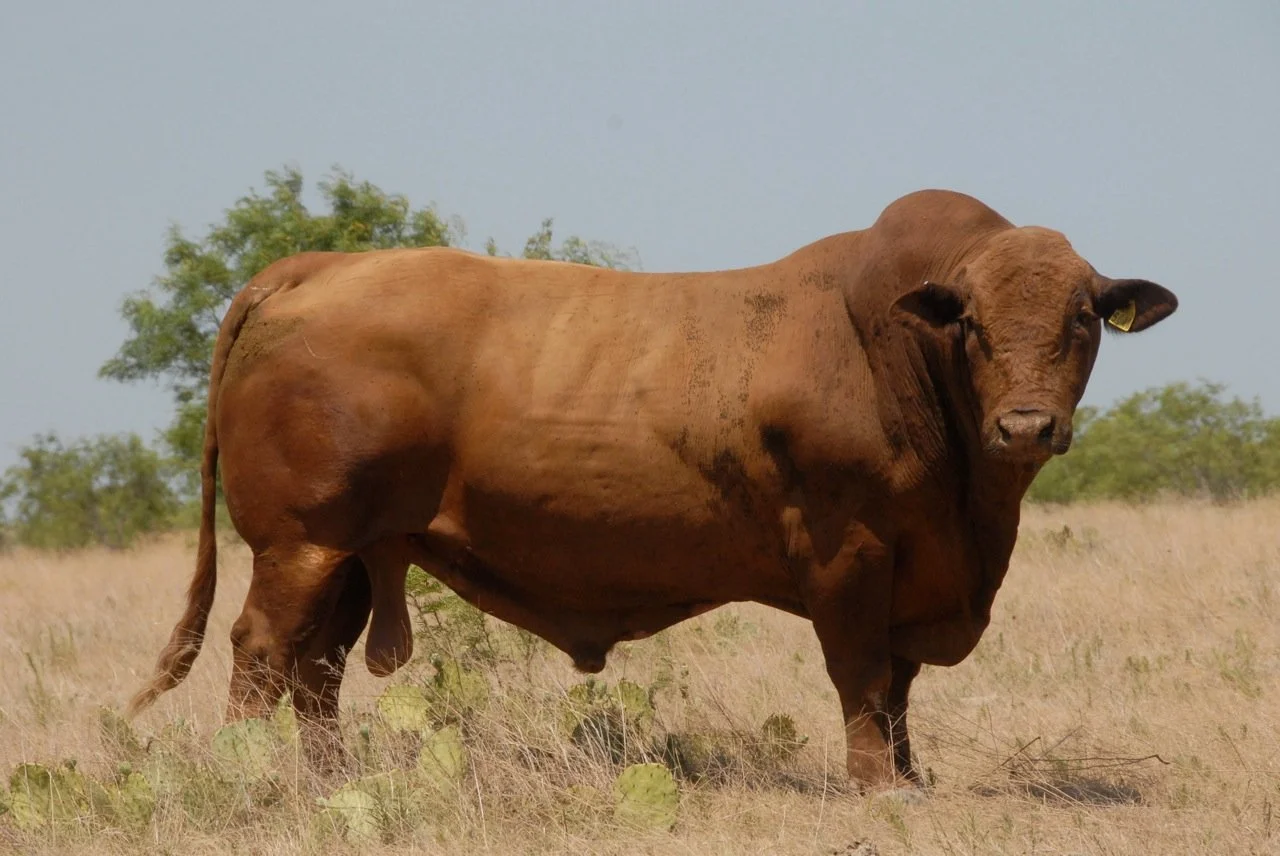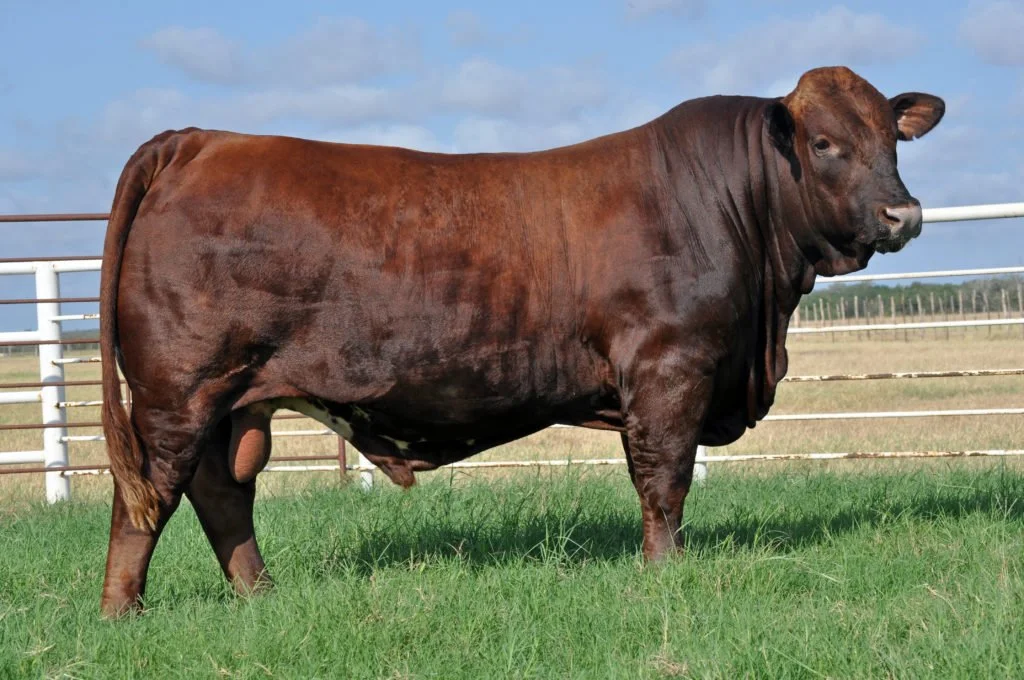Beefmaster Cattle: Key Insights and Benefits for Efficient Farming
Discover > Raising Cattle > Beefmaster Cattle: Key Insights and Benefits for Efficient Farming
In the early 1930s, Beefmaster (What wine goes well with beef?) cattle emerged from crossbreeding Hereford, Milking Shorthorn, and Brahman. Tom Lasater's approach combined 25% Hereford, 25% Milking Shorthorn, and 50% Brahman to create adaptable cattle with unique traits: disposition, fertility, weight, conformation, hardiness, and milk production. Their versatility and popularity led to global acclaim. Beefmaster Breeders United promotes these Six Essentials, enhancing demand for intelligent, gentle, and resilient cattle in the beef market.
Origin of Beefmaster Cattle
Beefmaster cattle, the only beef breed developed in South Texas, was meticulously crafted by Tom Lasater in 1931, building upon his father's work and the Lasater Ranch breeding program. This breed aimed to excel in beef production, adapt to harsh environments, and showcase fertility. It's a blend of Brahman, Hereford, and Shorthorn, with Brahman accounting for 50% and contributing heat adaptability. Hereford (25%) adds frame and growth, while Shorthorn (25%) brings mothering skills, milk production, and early maturity. Beefmaster cattle are renowned as a profit breed that excels uniquely in the beef industry.
Selective breeding, amalgamating Brahman hardiness, Hereford frame, and Shorthorn breeding, differentiates Beefmaster cattle. This harmonious blend led to USDA recognition in 1954. Today, Beefmaster Breeders United, the fifth-largest breed registry in the US, carries forward this legacy. The Beefmaster breed creation exemplifies the potency of combining diverse traits from a registered Hereford herd, registered Shorthorn bulls, and Brahman genetics to forge a highly productive and adaptive breed, now integral to the beef industry's success.
The Pros and Cons of Beefmaster Cattle
Physical Attributes
The Beefmaster breed makeup is a combination of Hereford, Shorthorn, and Brahman crossings, likely resulting in a foundation herd with approximately 25% Hereford, 25% Milking Shorthorn, and 50% Brahman genetics, which originated in the early 1930s.
Moderate in size, males range from 1,800 and up to 2,300 pounds for a Beefmaster bull weight, while females range from 1,100 to 1,700 pounds. Color spans light to dark red, some with white mottle on faces. Thick, loose skin resists pests, boosting hardiness. Selective breeding yields polled (hornless) variants, supplementing horned individuals. Disadvantages of Beefmaster cattle are few, such as coloration and slower breeding rate compared to some breeds.
Behavior
Beef master cows boast a balanced suite of Six Essentials: weight, conformation, milk production, fertility, hardiness, and disposition. This mix suits novice farmers, as they are manageable.
Hardiness, rooted in Brahman genetics, aids adaptation to harsh conditions. Females excel as mothers raising robust calves annually. Bulls' vigor contributes to productive operations. Their docility eases management. In various settings, Beefmaster cattle shine, making them a sought-after breed.
Reproductive Capabilities
Beefmaster cattle excel in reproduction, benefiting from bulls' pivotal role in breeding for fertility and program success. Bull fertility hinges on factors like health, structure, and genetics.
Heifers contribute to this capability by entering puberty early, facilitating rapid breeding, and the expansion of developing breeding herds. Noteworthy is Beefmaster cattle's proficiency in calving ease, reducing challenges for first-time mothers and increasing calf survival rates. This strengthens herd productivity and profitability when developing Beefmaster cattle.
Managing Beefmaster bulls and heifers attentively, emphasizing genetics, nutrition, and health, sustains Beefmaster reproductive triumph. Novice and experienced ranchers find appeal in this breed's fertility, calving ease, and adaptability, forming a sturdy foundation cattle for efficient and lucrative beef cattle enterprises. It’s not unusual for ranchers to search out Beefmaster embryos for sale as a way of validating the genetics of their herd.
Beefmaster Cattle Breeding
Breeding Programs
Beefmaster cattle, a composite breed from Hereford, Shorthorn, and Brahman genetics¹, are supported by Beefmaster Breeders United. This organization emphasizes the "Six Essentials": weight, conformation, milking ability, fertility, hardiness, and disposition². Purebred and seedstock producers enhance genetic traits like milk production, maternal abilities, and adaptability³.
Selection Process
The selection process in Beefmaster breeding programs involves a precise evaluation of the Six Essentials to ensure the breed's dual-purpose nature. The "Six Essentials" are the key parameters for assessing cattle:
Weight: Cattle are weighed at different stages of their life to measure growth rate and efficiency.
Conformation: Physical appearance, including muscling, structural soundness, and balance, is assessed for both meat production and overall health.
Milking Ability: Evaluating udder quality and milk production potential guarantees that calves receive adequate nutrition for growth.
Fertility: Reproductive efficiency and early sexual maturity are important factors in maintaining a sustainable breeding program.
Hardiness: Adaptability to various climate conditions, disease resistance, and overall vigor are considered in the selection process.
Disposition: A docile temperament allows for easier handling of cattle, ensuring a more efficient and safer working environment when dealing with the animals.
This identifies cattle excelling in meat and maternal roles, excelling in milk production, nurturing offspring, and passing on desirable traits³.
Emphasizing Six Essentials, Beefmaster programs enhance overall quality and adaptability, ensuring their dual-purpose reputation for ranchers and producers³.
Footnotes
Disease Resistance and Longevity
Beefmaster cattle's resilience and disease resistance boost longevity by minimizing health concerns. Comprising 50% Brahman, 25% Hereford, and 25% Shorthorn, this composite breed's mix reinforces hardiness and disease tolerance.¹ This reduces treatment needs and expenses, enabling more efficient ranch management.²
Enhancing disease resistance involves bolstering individual coping mechanisms without complete infection prevention. Non-clinical factors like genetics and immune interactions contribute to resistance, suggesting potential for improved disease resilience in Beefmaster cattle.³ Overall, their disease tolerance aids health and sustainability, reducing costs and enhancing ranch efficiency.⁴
Beefmaster Cattle Industries
Beefmaster cattle, originating in the 1930s from 50% Brahman, 25% Hereford, and 25% Milking Shorthorn cattle, are the first American composite breed. Their versatility shines across industries.
In the meat sector, Beefmaster cattle excel in efficient weight gain and marbling, yielding tender, flavorful meat. Their adaptability suits various climates, attracting beef producers seeking hardiness.
Dairy farmers benefit from the Milking Shorthorn heritage, enhancing milk production. Beefmaster cattle's dual-purpose nature diversifies revenue streams to meet dairy demand.
In the leather industry, Beefmaster cattle offer durable, high-quality hides for goods like shoes, bags, and upholstery. Consistency in hide thickness ensures premium products.
Adaptable, resilient, and versatile, Beefmaster cattle elevate meat, dairy, and leather sectors. Their hardiness and appeal make them popular for breeders meeting market demands.
Visiting a Beefmaster Ranch in Texas
Beefmaster cattle, renowned for hardiness and adaptability, are a favored Texas breed. To explore them further, visiting a Texas Beefmaster ranch provides invaluable insights and a firsthand encounter with these remarkable animals.
One option is Emmons Beefmasters, near Fairfield, Texas. Steve and Cindy Emmons, with over 40 years of experience, showcase high-quality Beefmasters with performance and appeal, offering educational ranch visits.
Thickety Creek Farm, near Kirbyville, Texas, is another choice. Owners Cullin and Claire Smith emphasize black and red Beefmasters, prioritizing genetics and attentive care.
In the southern part of the state, Janssen Beefmaster Cattle in Victoria, Texas, is worth considering. With animals in diverse counties, they highlight the breed's adaptability.
Mockingbird Hill Ranch in Denison, Texas, is a seed stock producer of Beefmaster cattle, focusing on top-tier breeding, health, and care.
Visiting a Texas Beefmaster ranch offers an enlightening experience for enthusiasts, enabling interaction with knowledgeable owners and a closer look at these impressive animals.
Frequently Asked Questions
What are Beefmaster cattle's key characteristics?
Beefmaster cattle boast strong maternal traits, robust growth, and carcass abilities. They feature short, sleek, glossy coats ranging from light tan to dark red, often with white markings, offering resistance to heat, drought, and insects, ideal for hot and humid climates¹².
How is the temperament of Beefmaster cattle?
Beefmaster cattle possess a favorable disposition, ensuring easy handling. Renowned for calm and docile behavior³.
What's the average size of Beefmaster cattle?
Average size varies by gender. Mature males weigh 2,200 to 2,600 pounds, while mature females typically range from 1,100 to 1,600 pounds⁴.
What's Beefmaster cattle's primary use?
Beefmaster cattle serve as a dual-purpose breed, excelling in both strong maternal traits and efficient carcass production. With a genetic mix of 50% Brahman, 25% Hereford, and 25% Shorthorn cattle⁵.
Are Beefmaster cattle aggressive?
Typically, Beefmaster cattle exhibit docile and calm behavior. However, individual demeanor varies, requiring cautious handling³.
Footnotes
Tom Lasater Beefmaster book - The Lasater Philosophy of Cattle Raising, is considered one of the best books about cattle selection and livestock enterprise management.
https://beefmasters.org/blog/2021/nothing-beats-a-beefmaster ↩
https://domesticanimalbreeds.com/beefmaster-cattle-breed-everything-you-need-to-know/ ↩ ↩2




